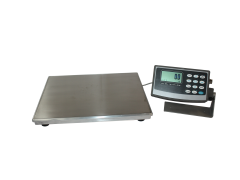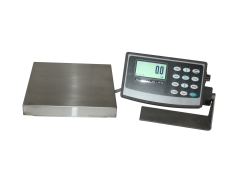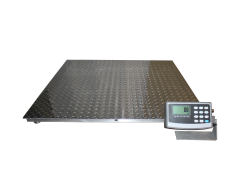 If you’re working in an environment where hazardous or flammable chemicals are present, you likely understand the need for equipment that is safe for use in these environments. Standard equipment, that’s not specifically designed for these extreme environments, can quickly catch fire, and cause a scenario where major damage is done, or possibly even injury or death. To prevent this potential problem, scale manufacturers must adhere to strict regulations surrounding the manufacturing of intrinsically safe scales.
If you’re working in an environment where hazardous or flammable chemicals are present, you likely understand the need for equipment that is safe for use in these environments. Standard equipment, that’s not specifically designed for these extreme environments, can quickly catch fire, and cause a scenario where major damage is done, or possibly even injury or death. To prevent this potential problem, scale manufacturers must adhere to strict regulations surrounding the manufacturing of intrinsically safe scales.
Regulations that govern the manufacturing and installation of electrical equipment in flammable and hazardous environments are managed by the Occupational Safety & Health Administration (OSHA), which has developed the National Electric Code (NEC).
The NEC breaks down their regulations into three different criteria listed below:
- Type – The type of hazardous materials that are being handled
- Condition – Indicates the environment when a certain material could become a hazard
- Nature – Details the flammable characteristics of the substance
Different NEC Hazardous Location Types
The NEC classifies three different types of locations that are deemed hazardous, all of which we’ll explain below.
Class I Locations
Class I locations include areas where flammable vapors or gases are present in amounts that could create the potential for some type of explosion, which then could ignite if an ignition source were present.
Areas that are often classified as Class I locations include aircraft hangers, petroleum refineries, spray finishing areas, and any facility that handles or stores natural gas or liquefied petroleum gas.
Class II Locations
Areas, where combustible dust is present, are typically deemed Class II locations. In these areas, flammable materials will often be suspended in the air and can cause a significant explosion if ignited.
Some common class II locations include feed and flour mills, grain elevators, plants that store or manufacture magnesium or aluminum powders, as well as cocoa and sugar plants.
Class III Locations
These locations include areas where fibers or flyings are present when various materials are stored, processed or handled. These materials are not typically found in the air but can collect around equipment where heat or a spark can cause them to catch fire.
Class III locations include flax processing plants, cotton gins, cottonseed mills, textile mills, and any manufacturing plants that create sawdust, which is obviously flammable.
Hazardous Location Conditions
The NEC also classifies how a material exists in one of the three location types listed above. Therefore, class I, II or III types can either be classified as Division I or II.
Division I: Normal
Division I environments are those where a hazard typically is present either in the daily operations of a facility, or during periods of maintenance and repair.
Division II: Abnormal
Division II environments are those where the hazard becomes apparent only during an accidental breakage, or equipment malfunction.
Nature of Hazardous Substances
The final component of the NEC classification system deals with the properties of individual substances and places them in different groups. Each group falls into one of the classes that were mentioned earlier in the article.
Groups A-D
These four groups are related to Class I locations and focus on the ignition temperature, as well as the explosion temperature of the flammable substance.
Group A contains only one substance, acetylene, which is a gas with high explosion temperatures. This material is quite rare in hazardous locations.
Group B also includes a small percentage of Class I areas. It includes hydrogen and other similar materials.
Group C and D are the most often used Class I groups and in turn make up the largest percentage of Class I hazardous locations. Group C includes ether and other similar materials and Group D typically refers to substances such as butane, gasoline, propane and natural gas.
Groups E-G
For Class II locations, the various groups are determined by the ignition temperature and conductivity of the substance. This is especially important in locations where metal dusts may be present.
Metal dusts are always classified within Group E. These materials include aluminum and magnesium dusts, as well as similar materials, all of which can be both conductive and explosive.
Group F areas contain coal dust, carbon black, charcoal dust, and other similar materials. Some of these materials are conductive, but all are explosive.
Group G contains cocoa, grain dusts, starch, flour and other similar materials. These materials are all explosive, but not conductive.
ArlynGuard Chemical Scales for Hazardous Environments
At Arlyn Scales, we offer our ArlynGuard scales which are intrinsically safe for hazardous and flammable environments. These scales are safe and approved to be used in the following environments:
- Class I, Divisions I-II, Groups A-D
- Class II, Divisions I-II, Groups E-G
- Class III, Divisions I-II
ArlynGuard B Scales
Bench scales ideal for capacity ranges between 5-150 pounds.
ArlynGuard C Scales
Drum scales with capacities between 60-400 pounds.
ArlynGuard P Scales
Platform scales that are ideal for larger applications, with capacities between 500-1000 pounds.
ArlynGuard F Scales
Floor scales with a wide array of capacity options from 2500-25000 pounds.
Purchase a Chemical Scale from the Experienced Team at Arlyn Scales
At Arlyn Scales, we’ve been designing and manufacturing scales for more than 30 years. All of our scales are built in the U.S., where our scale designers work hard to ensure our scales are not only available at prices that are competitive in the market, but also have features that make them extremely easy to use in a wide array of environments. If you’d like to learn more about our ArlynGuard scales, don’t hesitate to reach out to our team by phone at 800-645-4301 or through our online contact form. We’re confident that we can find a scale that will work for you, even if you’re in a location that has been deemed as hazardous.




